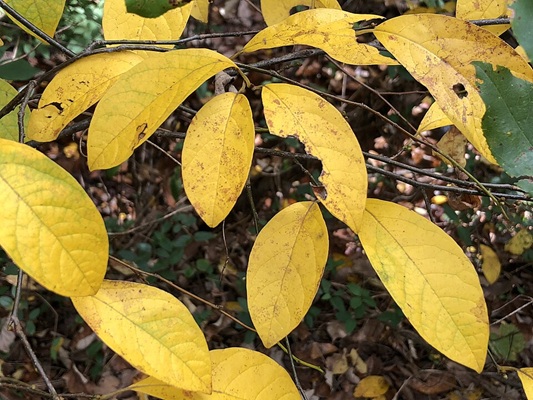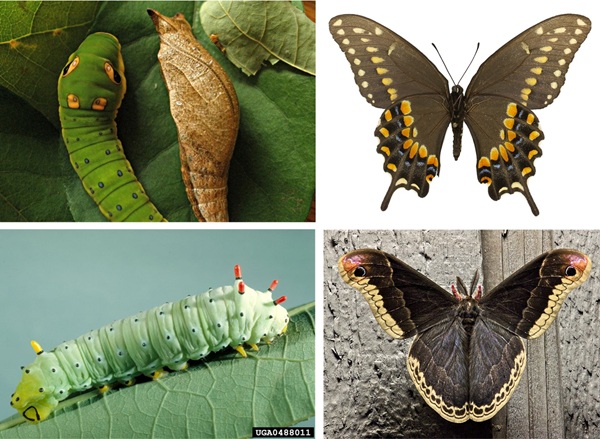
At a glance:
- Soil needs: Accepts a wide range of pH as well as a wide range of types, from loam to clay to sand, but must be moist and fairly well-draining. It is also known to prefer very fertile, rich soils.
- Water needs: Medium water needs. Benefits from watering every 1-2 weeks, especially until established.
- Sun needs: Will grow in full sun, but tolerates shade extremely well.
- Size needs: Considered an understory shrub — grows to a max height of around 12 feet, with a similar maximum width.
- Growth rate: Moderate, up to 1-2 feet per year. However this depends on the conditions: it will grow slower (albeit very successfully) in shadier spots.
- Tolerates Black Walnut: Yes, this shrub can be planted near black walnut.
- Wildlife value: Very high. While not a match for Oak or Cherries/Plums in terms of the number of insects it supports, a thriving forest also requires a productive understory. In terms of understory plants, Northern Spicebush is top-notch, supporting many amazing months and butterflies, as well as mammals.
A bit more…
The Northern spicebush (Lindera benzoin) may be a plant that you largely fail to notice, depending on when you cross its path. It’s usually about head-height or so, and it has fairly standard growth habit and foliage. But don’t let that fool you — the spicebush is a superstar that deserves to be in your forest or yard. If you encounter it earlier in the year, it certainly won’t fail to wow you: the flowers are a delightfully unique lime green, and they emerge early in spring, helping support insects who need food when fewer flowers are blooming. The berries also get bright red later in summer, and are very beautiful in their own right. The shrub even has some decent fall color, turning a deep yellow.

The Northern spicebush is also an incredibly versatile native understory species. In my mind, this makes them very valuable, because the understory of a forest is very important, but we often forget about it in our own landscaping. Almost by definition, understory plants must be shade tolerant, which many of our stereotypical favorites are not. It can sometimes feel difficult to find shade tolerant plants to use in our landscaping, but the answer is simple: look to the forest! Luckily, the spicebush will also grow in full sun, so you can plant it somewhere sunny while young trees have yet to form a canopy, and it will continue to thrive once they do.

Lindera benzoin also thrives in a variety of soils. However, for the most part, the soils must be fairly rich and moist. This is especially useful for me, since my area is a rather swampy, but quite rich, bottomland forest. In fact, long ago, early pioneers and land surveyors considered the spicebush as a sign of fertile lands worthy of settling. But beyond the “rich and moist” requirement, they do tolerate some soil types which can be hard to accommodate, such as sandy, silty, or even very thin with exposed limestone. They can also be relatively drought-tolerant, once established. It also has a quite extensive root system. This makes it very valuable for supporting the soil microbial ecosystem, as well as for controlling erosion. According to some, this also makes it hard to transplant. However, I have found it to be one of the easiest to transplant, with almost no failures at all — I guess this is another one of the benefits of working with small baby plants!

Where this plant really shines is in the number of ways it supports local ecosystems. The leaves and twigs are a favored food of deer, rabbits, and opossums (which means it must be protected when young!). The berries are also a favorite food of small mammals as well as many birds, both gamebirds and songbirds. Some favorites include pheasant, grouse, and wood thrush. It also is a big help to insects, and supports many butterfly/moth caterpillars, including some of our most cherished. It supports several species of swallowtail butterflies, and is a crucial host plant to one in particular, the Spicebush Swallowtail (Papilio troilus). It also hosts some of our most beautiful moths, such as the Cynthia moth (Samia cynthia) and Imperial moth (Eacles imperialis). It is also a crucial host to the Spicebush Silkmoth (Callosamia promethea), another stunning beauty. Indeed, the northern spicebush will really help get your local ecosystem firing on all cylinders, and attract some of the most beautiful insects our continent has to offer!

